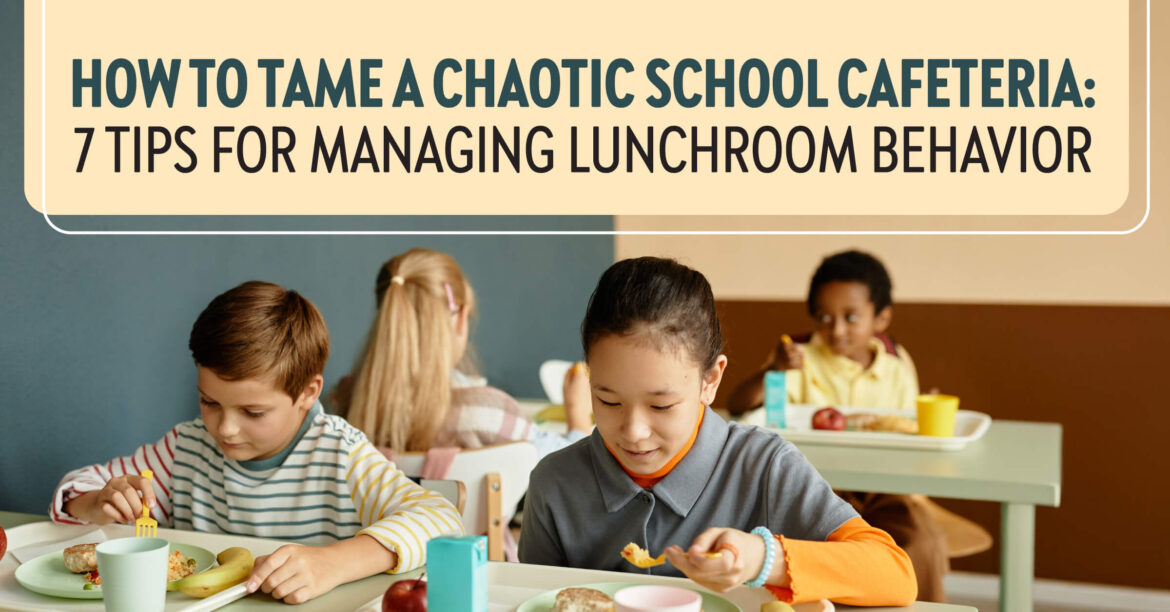By Laura Mooiman, LCSW
Have you ever been in an uproarious, ear-splitting cafeteria with clangs and shrieks echoing from every shiny surface?
I recently visited an elementary school cafeteria where students were rushing around in clumps and groups, with no teachers or staff in sight. They were allowed to sit anywhere they wanted and, as a result, some kids were milling around in uncertainty, while others raced from table to table in hyperactive glee. Students shouted louder and louder in order to be heard over the deafening noise of dozens of conversations, the scraping of chairs, and the clattering of trays.
Finally, I watched as two boys began arguing and actually pulled each other to the floor. Staff sent them to sit at the “red cone table” (aka. the “naughty table”). Then the rest of the kids began to stand up and throw their untouched food away before swarming to the doors, waiting to be released by the staff so they could go play. At the same time, the supervisors started putting the tables away with loud crashes and bangs. Wham wham wham! I about jumped out of my skin.
Is this what lunchtime is like at your school? It doesn’t have to be.
Here are a few simple suggestions to make the cafeteria or outdoor eating area better for both kids and adults alike.
1. Timing Matters
Supervision staff should be on time so the teachers and kids can eat. Just two minutes late and the whole system begins to fall apart. If the supervisor schedule is set up in a way that prevents even a single staff member from being on time, then the schedule needs to be changed.
Food should also be served on time. Food service workers should not serve kids until an exact time that everyone has agreed upon, and only when adults are present to supervise the students.
2. Lines Are Good for Kids
It may sound rigid to have kids walk in lines, but an orderly school means peace, calm, and safety for everyone. Students should learn and practice walking in straight lines with their hands at their sides and facing forward. Teachers should walk students in a single file line from the classroom all the way to the cafeteria (instead of just standing in the doorway and watching them go). Only when teachers see that supervision staff are present in the cafeteria can they leave to get their own lunches.
3. Assigned Seats
In order to reduce social anxiety and noise, have students sit at a designated table with their class. When kids know where to sit, they don’t need to struggle through the social minefield of asking peers if they can join.
If you are a fan of social mixing, just add some structure. For example, put one class on one side of the table and another class on the other. As long as the table is assigned, most kids’ anxiety can stay in check.
4. Volume Tricks
If volume is an issue in the cafeteria, try seating kids only on one side of the table. Many of the volume issues come from kids yelling across the table to their peers. When students focus on talking to the person next to them instead, noise levels are significantly reduced. If you don’t have space for this, just put students of different grade levels across from each other. You don’t often see 3rd graders having deep discussions with 1st graders.
Be mindful of students with sensory needs. Aside from just voices, the echoing capacity of a cafeteria is further amplified when you add slamming tables and trays and doors into the mix. Is there anything you can do about reducing these activities until students are dismissed?
5. Recess Before Lunch
By changing the order of when kids play and eat, you can encourage students to finish more of their lunch, eat more fruits and vegetables, and have fewer upset stomachs. They return to class calmer—with all the wiggles out—and ready to focus and learn. Some schools even report fewer nurse visits and less food waste with this strategy, making it a no-cost, win-win option for both kids and staff.
6. Visual Cues
I once knew an elementary school custodian who managed an entire lunch routine with 200 students at a time using only hand signals. To this day, I still don’t know how this particularly gifted individual became the lunch monitor, but the staff sure didn’t stand in his way. Students watched him and responded to cues to clean up, be seated, quiet down, and be excused all with hand motions. It was remarkable.
In the absence of such a talented custodian, I have found the Cone System to be replicable at most elementary schools. It has supervision staff use visual cues of red, yellow, and green cones at the end of each table.
While students are eating, the cone is set to red. During this time, lunch supervisors move up and down the aisles delivering positive contact and reinforcement, while also correcting behavior as necessary. Then, once it’s time to clean up, the supervisor changes the red cone to a yellow one. Kids see the yellow cone, and even if they didn’t hear the instruction, they know they can get up and start clearing their area. This includes picking up any trash on the floor.
Finally, when the supervisor decides the students have sufficiently cleaned their table and are sitting respectfully, the yellow cone can be switched to a green one. Now it is time for the teacher to walk their students quietly back to class (or to the playground) in a line.
7. Transitions Are Not Your Friend
Probably the most common issue I see in lunchtime routines is too many transitions. Students are sitting to eat, then are excused to clear their tray and return to the table, then are excused to line up somewhere, then they walk to a mid-way point and wait for the yard supervisor to release them to the playground.
Anyone who has worked or even lived with kids for any length of time knows the hardest thing to do is to get them from Point A to Point B—whether it’s from dinner to bath time, or from their desk to the pencil sharpener.
Transitions by nature mean a lack of structure, a lack of supervision, and an increase in chaotic interactions with peers. When we ask kids to transition too many times it taxes their patience and their coping skills. They make poor choices, engage in peer conflict, and generally have more behavioral errors.
The solution here is to eliminate any unnecessary transitions. For example, excuse students directly from their table to the playground in a single-file line—no extra steps or “holding tanks.” Station supervisors at key transition points like the trash bins, exit doors, or hallway corners, where things tend to unravel. This keeps the flow moving and gives adults a chance to offer positive reinforcement or quick redirection when needed. And while you’re at it, create a single, predictable exit route for all your students to follow, in order to cut down on wandering and random run-ins with other lunch groups.
Let’s face it—most staff don’t volunteer for cafeteria duty. But with a few thoughtful tweaks, lunch doesn’t have to be the noisiest, most dreaded 30 minutes of the day. By incorporating these simple system shifts, you can trade lunchtime chaos for something that feels calm, kind, and maybe even a little bit fun.
Laura Mooiman, LCSW, is an international education consultant, speaker, and creator of Restorative PBIS™, a trademarked framework that integrates Restorative Practices, PBIS, and MTSS to improve school culture and student behavior. With over 25 years of experience as a school social worker and district administrator, she has supported more than 600 schools across 22 countries and has been honored with two U.S. Congressional Recognitions for Outstanding Service to the Community.



